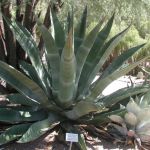| Common Name: |
Maguey |
| Other Names: |
Century Plant |
| Botanical Name: |
Agava americana |
| Genus: |
Agave |
| Family: |
Agavaceae |
| Native Location: |
Mexico, widely naturalized in India, Africa, and S Europe. |
| Cultivation: |
Well-drained soil in full sun. Prone to attack by mealybugs. Rot may occur during cool winter temperatures if plants are overwatered. |
| Propagation: |
By seed sown in spring at 21°C (70°F); by offsets, removed from the parent plant in spring or summer and left for some days to dry off before potting. |
| Harvest: |
Parts are harvested and processed as required. Leaves and root may be used fresh or dried; they last well when dried. |
| Warning: |
Skin allergen |
| Height: |
2m (6ft), reaching 8m (25ft) at flowering. |
| Width: |
3m (10 ft) |
| Variations: |
Marginata
Yellow-margined leaves
Mediopicta
Central, pale yellow band
Striata
Yellow or white stripes down each leaf. |
| Hardiness: |
Min. 5°C (41°F) |
| Parts Used: |
Whole plant, leaves, roots, sap. |
| Properties: |
A healing anti-inflammatory, diuretic herb with hormonal and insecticidal constituents. It acts mainly on the digestive system, but its intake can also lower fever by increasing perspiration. |
| Medicinal Uses: |
Internally for indigestion, flatulence, constipation, jaundice, and dysentery. Externally for burns and minor injuries. Fresh sap in contact with skin may cause skin irritation or dermatitis. |
| Culinary Uses: |
Sweet sap from the flowering stem is drunk as juice or fermented into pulque. Flower stems and leaf bases are roasted and eaten. |
| Economic Uses: |
Root extracts are used in soap manufacture, and the coarse fibers are woven into ropes, twine and mats. Leaf-waste concentrate provides certain precursors for steroid drugs. |
| Bibliography: |
Encyclopedia of Herbs by Deni Brown Copyright © 1995, 2001 Dorling Kindersley Limited. Pg 106 |

